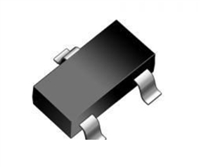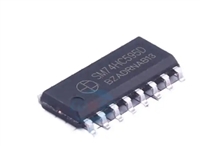ISL72028SEH
Low Power Shutdown Mode
Functional Description
Overview
The Intersil ISL72028SEH is a 3.3V radiation tolerant CAN
transceiver that is compatible with the ISO11898-2 standard for
use in CAN (Controller Area Network) serial communication
systems.
When a high level is applied to the RS pin, the device enters the
low power shutdown mode in which the driver and receiver are
switched off to conserve power. The bus pins are at High Z and R
pin will be at logic high. In low power shutdown the transceiver
draws 50µA (max) of current.
A low level on the RS pin brings the device back to operation.
The device performs transmit and receive functions between the
CAN controller and the CAN differential bus. It can transmit and
receive at bus speeds of up to 1Mbps. It is designed to operate
over a common-mode range of -7V to +12V with a maximum of
120 nodes. The device is capable of withstanding ±20V on the
CANH and CANL bus pins outside of ion beam and ±16V under
ion beam.
Using 3.3V Devices in 5V Systems
Looking at the differential voltage of both the 3.3V and 5V
devices, the differential voltage is the same, the recessive
common-mode output is the same. The dominant
common-mode output voltage is slightly lower than the 5V
counterparts. The receiver specs are also the same. Though the
electrical parameters appear compatible, it is advised that
necessary system testing be performed to verify interchangeable
operation.
Slope Adjustment
The output driver rise and fall time has three distinct selections
that may be chosen by using a resistor from the RS pin to GND.
Connecting the RS pin directly to GND results in output switching
times that are the fastest, limited only by the drive capability of
the output stage. RS = 10kΩ provides for a typical slew rate of
8V/µs and RS = 50kΩ provides for a typical slew rate of 4V/µs.
Split Mode Termination
The VREF pin provides a V /2 output voltage for split mode
CC
termination. The VREF pin has the same ESD protection, short
circuit protection and common-mode operating range as the bus
pins.
Putting a high logic level to the RS pin places the device in a low
power shutdown mode. The protocol controller uses this mode to
switch between low power shutdown mode and normal transmit
mode.
The split mode termination technique is shown in Figure 19.
VREF
VREF
NODE
#1
NODE
#2
NODE
#n
Cable Length
The device can work per ISO11898 specification with a 40m
cable and stub length of 0.3m and 60 nodes at 1Mbps. This is
greater than the ISO requirement of 30 nodes. The cable type
specified is twisted pair (shielded or unshielded) with a
characteristic impedance of 120Ω. Resistors equal to this are to
be terminated at both ends of the cable. Stubs should be kept as
short as possible to prevent reflections.
CANH
60Ω
60Ω
C
C
L
L
60Ω
60Ω
CANL
FIGURE 19. SPLIT TERMINATION
Cold Spare
High reliability system designers implementing data
It is used to stabilize the bus voltage at V /2 and prevent it from
CC
drifting to a high common-mode voltage during periods of
inactivity. The technique improves the electromagnetic
compatibility of a network. The split mode termination is put at
each end of the bus.
communications have to be sensitive to the potential for single
point failures. To mitigate the risk of a failure, they will use
redundant bus transceivers in parallel. In this arrangement, both
active and quiescent devices can be present simultaneously on
the bus. The quiescent devices are powered down for cold spare
and do not affect the communication of the other active nodes.
The C capacitor between the two 60Ω resistors, filters unwanted
L
high frequency noise to ground. The resistors should have a
tolerance of 1% or better and the two resistors should be
carefully matched to provide the most effective EMI immunity. A
To achieve this, a powered down transceiver (V < 200mV) has
CC
a resistance between the VREF pin or the CANH pin or CANL pin
and the VCC supply rail of >480kΩ (max) with a typical resistance
>2MΩ. The resistance between CANH and CANL of a
typical value of C for a high speed CAN network is 4.7nF, which
generates a 3dB point at 1.1Mbps. The capacitance value used is
dependent on the signaling rate of the network.
L
powered-down transceiver has a typical resistance of 80kΩ.
FN8764.1
November 9, 2015
Submit Document Feedback
10










 NE5532P芯片资料:引脚说明、电气参数及替换型号推荐
NE5532P芯片资料:引脚说明、电气参数及替换型号推荐

 解读MMBT5401数据手册:电气参数及替换型号推荐
解读MMBT5401数据手册:电气参数及替换型号推荐

 深入解读BAV70数据手册:特性、电气参数及替换型号推荐
深入解读BAV70数据手册:特性、电气参数及替换型号推荐

 74HC595D芯片引脚图及功能、参数介绍、替代型号推荐
74HC595D芯片引脚图及功能、参数介绍、替代型号推荐
